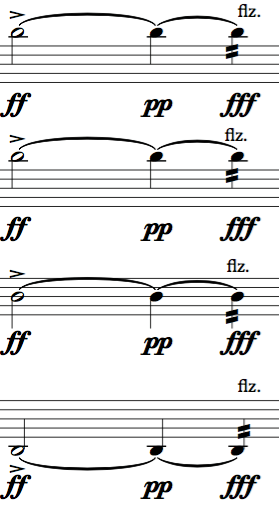It Felt Like Drowning
The header image shows ‘In the same breath’, a 2008 artwork by artist and glass-blower Kate Williams (borosilicate glass / 40 x 125 x 40 cm / courtesy of the artist / Photo © Yiannis Katsaris. See Kate Williams’s website for a video of the glass trombone being played). This work and many others are part of the upcoming Royal West of England Academy exhibition ‘Air: Visualising the Invisible in British Art 1768-2017‘.
It Felt Like Drowning is the winner of the Inspired composition competition. Entrants were asked to attend the Feel It festival in November 2016 and take their inspiration from one of the events, exhibitions, talks, films or panel discussions they went to. Feel It was an arts festival on pain, breathlessness and performance, and It Felt Like Drowning draws on material from A Painful Silence, a panel discussion on domestic violence led by Prof. Gene Feder OBE. The piece was written for acclaimed trombone quartet Bones Apart, and will be premiered in Bristol at a free concert on April 28th. Composer and PhD student Elan Higueras writes:
It Felt Like Drowning explores the pain and suffering experienced by victims of domestic violence. Breathlessness, anxiety and silent resilience are expressed musically in this trombone quartet.
One of the main obstacles in the fight against domestic violence abuse is silence. In the UK one in four women will experience domestic violence, yet only 35% of cases are reported to the authorities. In addition, a victim is attacked thirty five times on average before she contacts the police. Women and men in this situation live in a suffocating and oppressive silence that is hard to escape from. In this piece, I have expressed this silence in two different ways. Firstly, performers are required to use plunger and straight mutes. Through this, I intend to create a parallel between the muffled sound of the muted trombone and the forcefully silent voice of the victims of domestic abuse. Secondly, the main motive of the piece is a rhythmic transcription of the word ‘breath’ in Morse code. I have based my piece around this encrypted word to reflect the secrecy behind domestic violence and the silent cries for help of many of its victims. However, in this quartet the message is not directed to those outside, but it is an inner dialogue between the victim and herself. Here, she reminds herself to breathe, but she does it in code to reflect the reluctance of some victims to admit the problem to themselves.
-… .-. . .- – ….
Fear and anxiety are emotions that victims of domestic abuse violence suffer with intensity. In my piece I have represented these experiences with chorale-like sections. Long notes with tension-building crescendos, quarter-tone clashes and flutter tongue effects reflect the constant fear in which victims live. This is accentuated by sudden dynamic explosions that equate to bursts of panic caused by the attacks.

Oppressive silence, anxiety and fear are physically expressed through breathlessness. In this quartet, breathlessness is integrated in the performance. First, in the choral introduction, performers need to hold a note for a long period of time while precisely controlling dynamic changes. They also have to quickly proceed to the next note, what forces the performers to quickly take a rushed and somewhat unsatisfactory breath. Furthermore, the way the rhythmic cells are displayed in the piece, while possible to perform, will make the performers feel breathless, as there are no long rests. Also, continuous short interruptions make breathing awkward for brass players. Finally, I have included cross-harmonic slurs in the piece. To perform these, trombonists have to fight the resistance created by the harmonic series with their breath. I have used these slurs as a symbol of breathlessness and to recreate the feeling of drowning that many victims of domestic abuse experience.
Hear the full peice performed by Bones Apart.
Elan Higueras is a Bristol-based composer and trombonist. His works have been performed across the UK and Europe, appearing in festivals such as NAK (Contemporary Music Festival of Navarre), the Spanish Trombonist Association Conference and New Music in the South West, to name a few. He is currently a PhD student at the University of Bristol, reading composition.





2 Comments
Pingback: A Painful Silence: bringing domestic violence into conversation – Life of Breath
Pingback: The uses and abuses of air (2) – Life of Breath